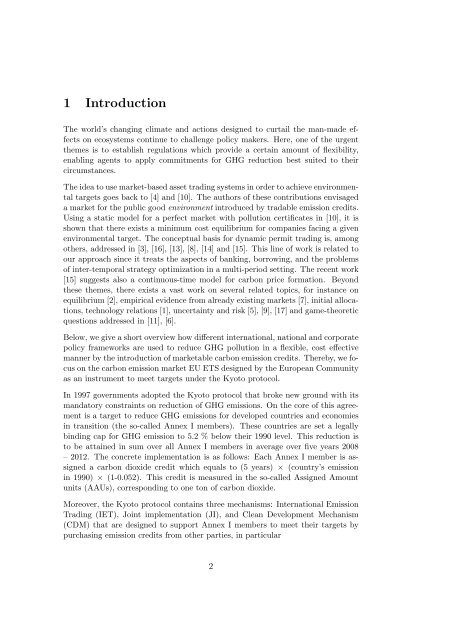A quantitative approach to carbon price risk modeling - CiteSeerX
A quantitative approach to carbon price risk modeling - CiteSeerX
A quantitative approach to carbon price risk modeling - CiteSeerX
Create successful ePaper yourself
Turn your PDF publications into a flip-book with our unique Google optimized e-Paper software.
1 Introduction<br />
The world’s changing climate and actions designed <strong>to</strong> curtail the man-made effects<br />
on ecosystems continue <strong>to</strong> challenge policy makers. Here, one of the urgent<br />
themes is <strong>to</strong> establish regulations which provide a certain amount of flexibility,<br />
enabling agents <strong>to</strong> apply commitments for GHG reduction best suited <strong>to</strong> their<br />
circumstances.<br />
The idea <strong>to</strong> use market-based asset trading systems in order <strong>to</strong> achieve environmental<br />
targets goes back <strong>to</strong> [4] and [10]. The authors of these contributions envisaged<br />
a market for the public good environment introduced by tradable emission credits.<br />
Using a static model for a perfect market with pollution certificates in [10], it is<br />
shown that there exists a minimum cost equilibrium for companies facing a given<br />
environmental target. The conceptual basis for dynamic permit trading is, among<br />
others, addressed in [3], [16], [13], [8], [14] and [15]. This line of work is related <strong>to</strong><br />
our <strong>approach</strong> since it treats the aspects of banking, borrowing, and the problems<br />
of inter-temporal strategy optimization in a multi-period setting. The recent work<br />
[15] suggests also a continuous-time model for <strong>carbon</strong> <strong>price</strong> formation. Beyond<br />
these themes, there exists a vast work on several related <strong>to</strong>pics, for instance on<br />
equilibrium [2], empirical evidence from already existing markets [7], initial allocations,<br />
technology relations [1], uncertainty and <strong>risk</strong> [5], [9], [17] and game-theoretic<br />
questions addressed in [11], [6].<br />
Below, we give a short overview how different international, national and corporate<br />
policy frameworks are used <strong>to</strong> reduce GHG pollution in a flexible, cost effective<br />
manner by the introduction of marketable <strong>carbon</strong> emission credits. Thereby, we focus<br />
on the <strong>carbon</strong> emission market EU ETS designed by the European Community<br />
as an instrument <strong>to</strong> meet targets under the Kyo<strong>to</strong> pro<strong>to</strong>col.<br />
In 1997 governments adopted the Kyo<strong>to</strong> pro<strong>to</strong>col that broke new ground with its<br />
manda<strong>to</strong>ry constraints on reduction of GHG emissions. On the core of this agreement<br />
is a target <strong>to</strong> reduce GHG emissions for developed countries and economies<br />
in transition (the so-called Annex I members). These countries are set a legally<br />
binding cap for GHG emission <strong>to</strong> 5.2 % below their 1990 level. This reduction is<br />
<strong>to</strong> be attained in sum over all Annex I members in average over five years 2008<br />
– 2012. The concrete implementation is as follows: Each Annex I member is assigned<br />
a <strong>carbon</strong> dioxide credit which equals <strong>to</strong> (5 years) × (country’s emission<br />
in 1990) × (1-0.052). This credit is measured in the so-called Assigned Amount<br />
units (AAUs), corresponding <strong>to</strong> one <strong>to</strong>n of <strong>carbon</strong> dioxide.<br />
Moreover, the Kyo<strong>to</strong> pro<strong>to</strong>col contains three mechanisms: International Emission<br />
Trading (IET), Joint implementation (JI), and Clean Development Mechanism<br />
(CDM) that are designed <strong>to</strong> support Annex I members <strong>to</strong> meet their targets by<br />
purchasing emission credits from other parties, in particular<br />
2
















